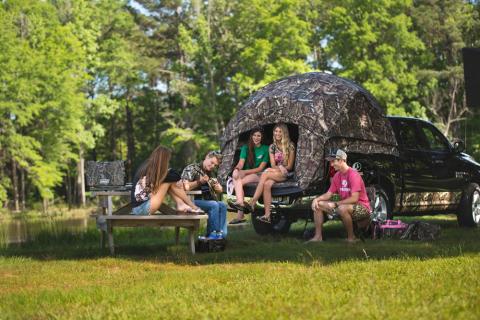Heath Wood
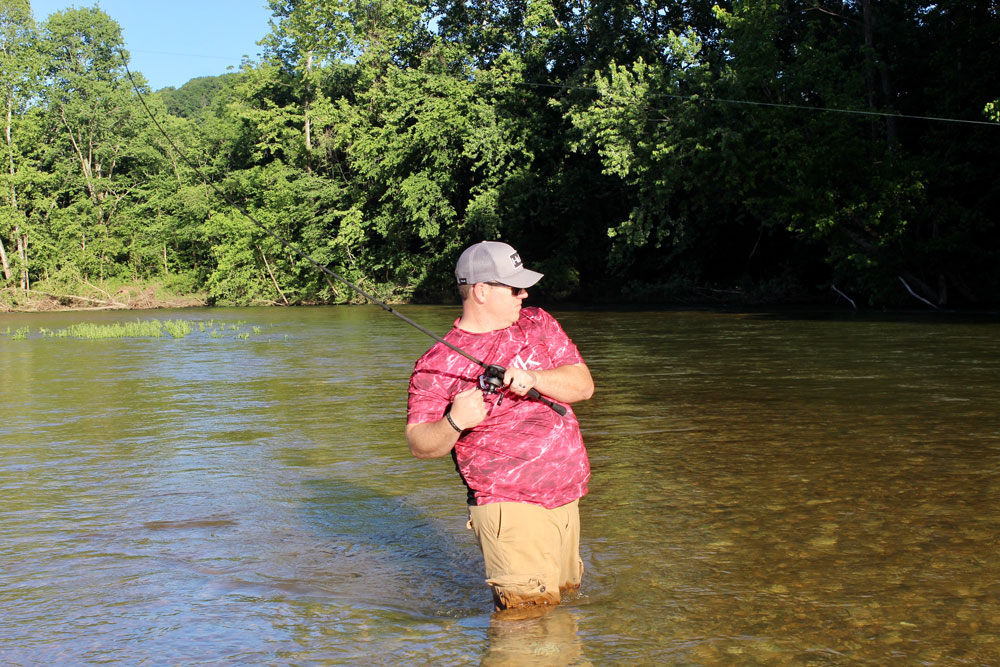
While sitting around the campfire on the first night of our 3-day trip, I told my wife that I was going to go to bed, because I wanted to get up at sunrise and be on the river to start fishing.
While doing a few last-minute preparations before hitting the sack, we laughed at how much easier it is to get up early when heading out to hunt or fish than it is to go to work. The truth is, whether it's getting up early to sit in a treestand, to hear a tom turkey gobbling while still on the roost or to cast a line into the water at sunrise to catch big bass, we do it because we know that this is the most active part of the day for an outdoorsman to have success. The thrill that comes from this knowledge and experience is what keeps our adrenaline high, and our anticipation elevated enough to be able to bounce out of bed before the first light of day.
As we enjoyed ourselves each day of our trip on the Jacks Fork River in southern Missouri, I began to realize that peak movement times and getting out of bed earlier than usual was not the only two similarities that hunters and fisherman have.
On this trip, I spent much of each morning and evening walking the banks and wading into the waters to try my hand at catching smallmouth bass and goggle-eye. As I walked along the quiet banks of the river, one of the many thoughts that entered my mind was how having success catching fish in small streams such as the Jacks Fork involves the same factors and techniques as when hunting successfully.
Best Time Of The Day
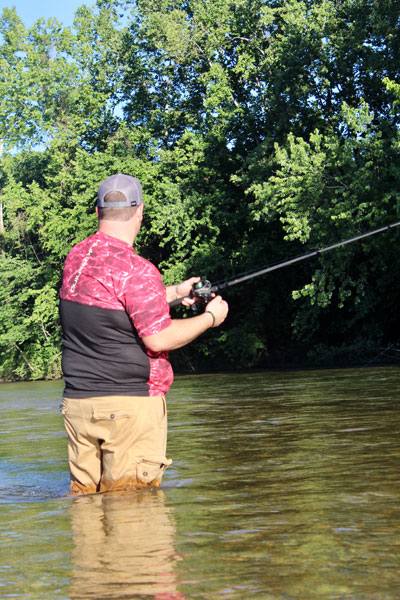 As mentioned earlier, one of the most significant similarities between hunting and fishing is the time of day. On the majority of most of my hunting and fishing trips, I enjoy early morning and late evenings the most. As with most animals and fish, these are the times that they are most active, mainly because of food. Early in the morning, it’s time to eat breakfast. It is the same with deer or fish; they are in search of food, thus being why the activity is at its highest.
As mentioned earlier, one of the most significant similarities between hunting and fishing is the time of day. On the majority of most of my hunting and fishing trips, I enjoy early morning and late evenings the most. As with most animals and fish, these are the times that they are most active, mainly because of food. Early in the morning, it’s time to eat breakfast. It is the same with deer or fish; they are in search of food, thus being why the activity is at its highest.
While walking the banks of the river fishing, I noticed that I caught more fish during the first couple hours of the day than any other part of the day, mainly because the fish were hungry and feeding on bait. In the small streams that I was fishing, one of the most popular food sources is crawdads: Smallmouth bass and goggle-eye love feeding on crawdads in the swifter parts of the current. My bait of choice was a plastic tube in a pumpkin color or something brown with a little green tinge to it. These baits best resemble the food that the fish are most likely feeding on.
Late evenings are like that of early mornings. Animals and fish are ready to feed before dark, also making it an excellent time to catch fish while feeding. Besides fish wanting to eat, another reason early mornings and late evenings seem to be more successful in that the temperatures are on the cooler side during these two times of the day. Again, another similarity to that of hunting. When temperatures are more pleasant, activity is going to increase.
Feeding Areas, Travel Routes and Scouting
The term pre-fish may not mean anything to someone who has not been around fishing tournaments. In many tournaments, anglers will get a day before the official competition to pre-fish. During this time, anglers will spend their time searching for spots with the most fish, and more importantly, finding the biggest fish.
The key to success while hunting or fishing is knowing where the animal or fish live, where they travel, and where they feed. To be able to find out where fish are located, anglers must spend time scouting, like that of a deer hunter. Anglers will search where fish are feeding, what bait they are fishing on, and where they spend the most time. By being prepared before a competition, the fisherman will be more successful when the time comes to weigh in.
On my fishing trips on the small rivers and streams in southern Missouri, I observed several small crawdads swimming around in the shallow water as I walked up and down the banks. By seeing a lot of bait in the water, I decided to use a plastic tube bait in multiple colors that resembled the crawdads.
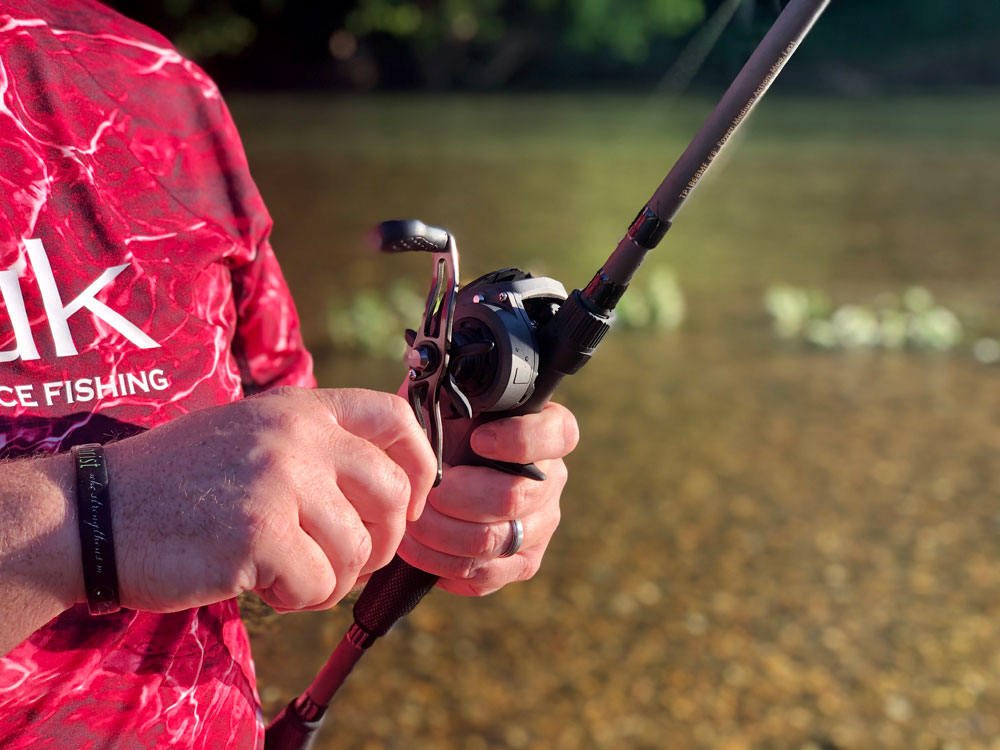
In the rivers and streams that I was fishing, one will find a lot of structures underneath the water. Things like trees, old logs, and rock ledges provide excellent cover for bass to hide under until the current brings food by them. While fishing a structure in the river, which has a constant flow, I elected to pitch and flip my plastic tubes upstream, letting the natural current pull my bait past the logs and rock ledges. By timing the depth of bait to be eye level with the fish when passing by the formation, I was able to get a lot of reactions from smallmouth. When flipping plastic tubes near a structure, I prefer using my Lew's Super Duty GX3 bait caster reel in a 6.5:1 gear ratio, paired with a Lew's Custom Black 6' 8" med/heavy rod. As for my line, I use Strike King's Fluorocarbon line in a 10-pound test because it easy to feel the smallmouth react to the bait and super tough, even around structures.
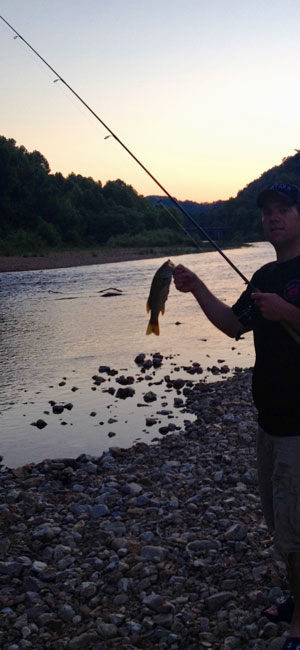 It is essential to carry a quality setup such as my Lew's rod and reel. When walking the banks fishing for smallmouth, one does not have the luxury to reach in a rod box and grab another pole if something tears up or quits working. Instead, I rely on proper equipment that will allow me to fish without interruption.
It is essential to carry a quality setup such as my Lew's rod and reel. When walking the banks fishing for smallmouth, one does not have the luxury to reach in a rod box and grab another pole if something tears up or quits working. Instead, I rely on proper equipment that will allow me to fish without interruption.
The key to success while hunting or fishing is knowing where they live, where they travel, and where they feed.
Stay Hidden
Another similarity between hunting and fishing - that I have found while walking the banks fishing small rivers and streams - is to stay hidden. When I say small rivers and streams, I mean I am fishing an area in which, from bank to bank, it will measure anywhere from 10-feet wide to 40-feet wide. Most of the time, I can wade across with no problems, except for being seen by fish.
When walking the banks and wading to fish, I try to stay far enough away from my casting target so that bass will not catch my movement. Some may think I am crazy; however, if the fish can see you walking or wading near them, they will not bite.
When deer hunting or even predator hunting, I continually use shadows and natural obstructions to keep from being spotted by an animal. The same goes when walking the banks or wading. I like to stay in the shadows if I am close to where I think the fish are going to be.
If one will pay attention to what is in between you and the fish, the chances of getting more bites will increase dramatically.
Over the years, I have always noticed the same men and women who passionately hunt in the fall and winter seem to be the same men and women who become as equally passionate about finding big fish in the spring and summer. It comes down to the similarities when pursuing both. It is easy to see that it is the thrill of seeking, finding, and pursuing that fuels the fire of our passion for being in the outdoors regardless of the time of year.














